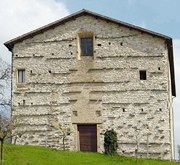


An oratory existed on this site in 1454, when the monks of the Abbazia di San Pietro gave it a fresco known as the Madonna della Piaggiola (see below). This oratory was named for “la piaggia”, the hillside on which it was built. In the same year, the Confraternita della Piaggiola obtained adjoining land so that it could extend the oratory. In 1582, the confraternity became associated with the Confraternita del Gonfalone, Rome.
In 1567, the monks of San Pietro donated a piece of land near the oratory to the confraternity so that it could build the present church to house the Madonna della Piaggiola. The foundation stone was laid in 1613 but the project then hit problems, and it was some time before work could begin. In, 1624, Vincenzo Chiocci , the prior of the confraternity, donated money for the completion of the work. The prior of San Pietro consecrated the church in 1625, despite the objection of Bishop Alessandro del Monte. The old oratory was subsequently demolished.
The Compagnia di San Francesco di Paola, which was formed here in 1710, moved to Santa Maria del Prato in 1717.
A statue of St Teresa of Avila (1731) was blessed in the Duomo before its installation in a chapel (2nd on the right) that was dedicated to her. At this time, she was proclaimed a patron saint dedicated to the protection of Gubbio from earthquakes.
The present church was closed in 1786 when the confraternity was suppressed, but it was nevertheless restored after the earthquake of 1984. It reopened in 1997, on the feast of St Teresa of Avila . The altarpieces, which had been removed for restoration, were returned in the following year.
Exterior
The façade, which is incomplete, incorporates stones low down on the right that seem to come from a Roman building.
Interior
The interior is in the form of a single nave with six side chapels, and has good Baroque decoration (1613-25).
Madonna della Piaggiola (early 15th century)
This fresco, which is attributed to Ottaviano Nelli, seems to have been painted for the Abbazia di San Pietro. As noted above, the monks gave it to what was then the Oratorio di Santa Maria della Piaggiola in 1454. An inscription on the wall to the left of the first chapel on the left records that it was moved from the earlier church to the high altar of the present church in 1624.
In this unusual iconography, the Madonna holds a small but mature figure of Christ, who in turn holds a scroll with a text that translates: “I am the light of the world: He who follows me shall not walk in darkness”.
Unfortunately, this important fresco has been heavily repainted.
Pietà (ca. 1450)
An inscription on the counter-façade recalls that this “old and miraculous” image in the Cappella della Pietà (the 1st on the right) was translated from the earlier church in 1646. An attribution to Giacomo di Benedetto Bedi recently replaced the traditional one to Domenico di Cecco. The image depicts the dead Christ in the sepulchre with the symbols of the Passion and with the Virgin and St Peter.
St Theresa in Ecstasy (ca. 1612)
The Piccini family commissioned this altarpiece in the Cappella di Santa Teresa d’ Avila (2nd on the right) from Ventura Mazza (died after 1635). It affords an early example of the popular iconography that was used again, for example, in the famous sculpture (1646) by Lorenzo Bernini in Santa Maria della Vittoria, Rome. Ventura Mazza presumably painted it after he had finished another altarpiece in Santa Maria dei Laici that had been begun by his master, by his master Federico Barocci. If so, it pre-dated the canonisation of St Theresa in 1622.
Crucifixion (1655)
The Andreoli family commissioned this altarpiece on the 2nd altar on the left. It depicts the moment when the dying Christ confers responsibility for His mother on St John the Evangelist. It is by/attributed to Giovanni Battista Michelini, il Folignate.
Pietà with SS Ubaldus and Crispin (1655)
This altarpiece by/attributed to Giovanni Battista Michelini, il Folignate is/was in Santa Maria della Piaggiola. [Dated by inscription ?]
Pentecost (1665)
This altarpiece, which is attributed to Francesco Allegrini, is on the 3rd altar on the left.
St Francis di Paola (17th century)
This altarpiece on the 1st altar on the left is attributed to Rutilio Manetti.

